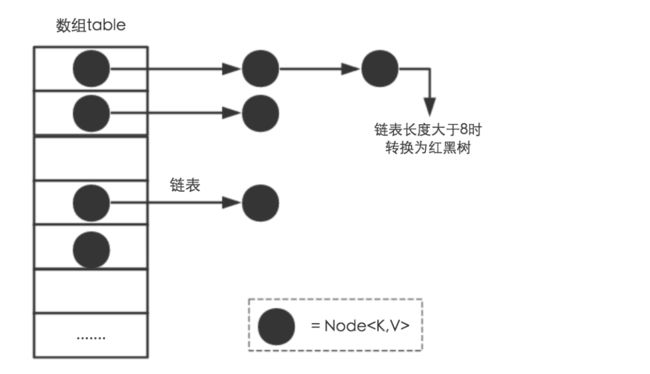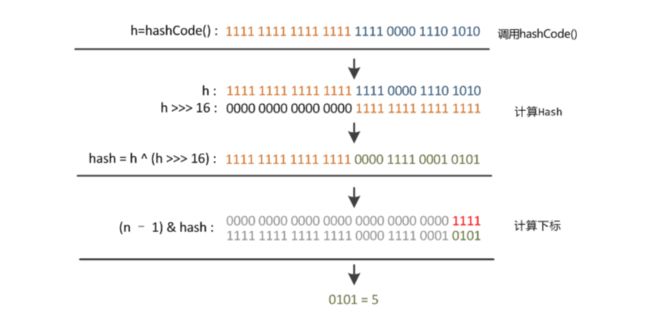HashMap是应用更加广泛的哈希表实现,行为上大致与HashTable一致,主要区别在于HashMap不是同步的,支持null键和值等。java 8中HashMap本身发生了特别多的变化,下面从源码角度分析HashMap的设计与实现
1.HashMap的数据结构
HashMap底层采用数组+链表+红黑树实现,数组中的每个下标存放一个或多个Node结点(可能是链表或红黑树,红黑树是java1.8新增的特性)。
数组的定义如下:
transient Node[] table;
Node
static class Node implements Map.Entry {
final int hash;//用来定位数组索引位置
final K key;
V value;
Node next;
Node(int hash, K key, V value, Node next) {
this.hash = hash;
this.key = key;
this.value = value;
this.next = next;
}
// ...
TreeNode
static final class TreeNode extends LinkedHashMap.Entry {
TreeNode parent; // red-black tree links
TreeNode left;
TreeNode right;
TreeNode prev; // needed to unlink next upon deletion
boolean red;
TreeNode(int hash, K key, V val, Node next) {
super(hash, key, val, next);
}
/**
* Returns root of tree containing this node.
*/
final TreeNode root() {
for (TreeNode r = this, p;;) {
if ((p = r.parent) == null)
return r;
r = p;
}
}
/**
* Ensures that the given root is the first node of its bin.
*/
static void moveRootToFront(Node[] tab, TreeNode root) {
int n;
if (root != null && tab != null && (n = tab.length) > 0) {
int index = (n - 1) & root.hash;
TreeNode first = (TreeNode)tab[index];
if (root != first) {
Node rn;
tab[index] = root;
TreeNode rp = root.prev;
if ((rn = root.next) != null)
((TreeNode)rn).prev = rp;
if (rp != null)
rp.next = rn;
if (first != null)
first.prev = root;
root.next = first;
root.prev = null;
}
assert checkInvariants(root);
}
}
2. HashMap的初始化
- 默认容量为16
static final int DEFAULT_INITIAL_CAPACITY = 1 << 4; // aka 16
- 最大容量为2 的 30 次方
static final int MAXIMUM_CAPACITY = 1 << 30;
- 默认的负载因子为0.75
static final float DEFAULT_LOAD_FACTOR = 0.75f;
4.门限值用于判断当元素数量大于该值时,进行扩容:
- 声明HashMap时,若指定初始容量时,值为初始容量最近的往上取2的n次方(如,初始容量为5,则门限值为8);
- 声明HashMap时,没有指定初始容量时,值默认为0
- 扩容后,值为容量*负载因子,若元素数量大于该值,则需重新进行扩容
// (The javadoc description is true upon serialization.
// Additionally, if the table array has not been allocated, this
// field holds the initial array capacity, or zero signifying
// DEFAULT_INITIAL_CAPACITY.)
int threshold;
来看构造函数,数组table没有在执行构造函数时进行初始化,仅仅只是设置一些属性的初值而已,
public HashMap(int initialCapacity, float loadFactor) {
if (initialCapacity < 0)
throw new IllegalArgumentException("Illegal initial capacity: " +
initialCapacity);
if (initialCapacity > MAXIMUM_CAPACITY)
initialCapacity = MAXIMUM_CAPACITY;
if (loadFactor <= 0 || Float.isNaN(loadFactor))
throw new IllegalArgumentException("Illegal load factor: " +
loadFactor);
this.loadFactor = loadFactor;
this.threshold = tableSizeFor(initialCapacity);
}
3.确定哈希桶数组索引位置
一共分为三步:
1.调用Object类的hashCode()方法计算hashCode值
2.HashCode右移16位,并与步骤1中的hashCode值进行^运算
3.取模运算
先来看看代码, hash方法进行步骤1和步骤2,返回hash值
static final int hash(Object key) {
int h;
return (key == null) ? 0 : (h = key.hashCode()) ^ (h >>> 16);
}
为什么要将hashCode值右移16位呢?通过右移得到高16位,并与低16位进行异或运算,这样可以确保高低Bit都能参与到hash值的计算,并且不会有太大的开销。
接下来,根据hash值与数组长度length的取模运算,得到索引位置,这里通过一种非常巧妙的方法实现取模运算,也就是i=(n - 1) & hash。由于HashMap底层数组的长度总是2的n次方,当length总是2的n次方时,h& (length-1)运算等价于对length取模,也就是h%length,但是&比%具有更高的效率。
final V putVal(int hash, K key, V value, boolean onlyIfAbsent,
boolean evict) {
Node[] tab; Node p; int n, i;
if ((tab = table) == null || (n = tab.length) == 0)
n = (tab = resize()).length;
// i= (n - 1) & hash得到索引值
if ((p = tab[i = (n - 1) & hash]) == null)
tab[i] = newNode(hash, key, value, null);
else {
......
}
下图详细展示了hash值的计算过程
4.HashMap的扩容机制
resize()函数负责初始化和扩容操作
- 如果数组为null,并且用户指定了初始容量,则新的容量以当前的门限值为准(门限值已在构造函数中初始化为初始容量最近的往上取2的n次方,如,初始容量为5,则门限值为8);新的门限值为新的容量*负载因子
- 如果数组为null,并且用户未指定初始容量,则新的容量为默认容量16,新的门限值为16*负载因子新的容量
- 如果数组不为null, 则容量和负载因子同时扩大为当前的2倍
在容量和门限值的设置完成后,如果数组不为空,也即进行的是扩容操作,需要将旧的table中的元素拷贝到新的table中。jdk 1.8在扩容方面有一些新特性,这里详细进行讲解。
4.1 jdk 1.7中的扩容
首先看下jdk 1.7中是如何进行扩容的,transfer方法负责将旧表中的数据拷贝到新表。拷贝的具体逻辑是:每次重新计算索引位置,并按照头结点插入的方式将最后插入的Node节点放在链表的表头。
void resize(int newCapacity) { //传入新的容量
Entry[] oldTable = table; //引用扩容前的Entry数组
int oldCapacity = oldTable.length;
if (oldCapacity == MAXIMUM_CAPACITY) { //扩容前的数组大小如果已经达到最大(2^30)了
threshold = Integer.MAX_VALUE; //修改阈值为int的最大值(2^31-1),这样以后就不会扩容了
return;
}
Entry[] newTable = new Entry[newCapacity]; //初始化一个新的Entry数组
transfer(newTable); //!!将数据转移到新的Entry数组里
table = newTable; //HashMap的table属性引用新的Entry数组
threshold = (int) (newCapacity * loadFactor);//修改阈值
}
void transfer(Entry[] newTable) {
Entry[] src = table; //src引用了旧的Entry数组
int newCapacity = newTable.length;
for (int j = 0; j < src.length; j++) { //遍历旧的Entry数组
if (e != null) {
src[j] = null;//释放旧Entry数组的对象引用(for循环后,旧的Entry数组不再引用任何对象)
do {
Entry next = e.next;
int i = indexFor(e.hash, newCapacity); //!!重新计算每个元素在数组中的位置
e.next = newTable[i]; //标记[1]
newTable[i] = e; //将元素放在数组上
e = next; //访问下一个Entry链上的元素
} while (e != null);
}
}
}
4.2 jdk 1.8中的扩容
下面看下jdk 1.8中在扩容方面有什么改进
final Node[] resize() {
Node[] oldTab = table;
int oldCap = (oldTab == null) ? 0 : oldTab.length;
int oldThr = threshold;
int newCap, newThr = 0;
if (oldCap > 0) {
if (oldCap >= MAXIMUM_CAPACITY) {
threshold = Integer.MAX_VALUE;
return oldTab;
}
else if ((newCap = oldCap << 1) < MAXIMUM_CAPACITY &&
oldCap >= DEFAULT_INITIAL_CAPACITY)
newThr = oldThr << 1; // double threshold
}
else if (oldThr > 0) // initial capacity was placed in threshold
newCap = oldThr;
else { // zero initial threshold signifies using defaults
newCap = DEFAULT_INITIAL_CAPACITY;
newThr = (int)(DEFAULT_LOAD_FACTOR * DEFAULT_INITIAL_CAPACITY);
}
if (newThr == 0) {
float ft = (float)newCap * loadFactor;
newThr = (newCap < MAXIMUM_CAPACITY && ft < (float)MAXIMUM_CAPACITY ?
(int)ft : Integer.MAX_VALUE);
}
threshold = newThr;
@SuppressWarnings({"rawtypes","unchecked"})
Node[] newTab = (Node[])new Node[newCap];
table = newTab;
if (oldTab != null) {
for (int j = 0; j < oldCap; ++j) {
Node e;
if ((e = oldTab[j]) != null) {
oldTab[j] = null;
if (e.next == null)
newTab[e.hash & (newCap - 1)] = e;
else if (e instanceof TreeNode)
((TreeNode)e).split(this, newTab, j, oldCap);
else { // preserve order
Node loHead = null, loTail = null;
Node hiHead = null, hiTail = null;
Node next;
do {
next = e.next;
if ((e.hash & oldCap) == 0) {
if (loTail == null)
loHead = e;
else
loTail.next = e;
loTail = e;
}
else {
if (hiTail == null)
hiHead = e;
else
hiTail.next = e;
hiTail = e;
}
} while ((e = next) != null);
if (loTail != null) {
loTail.next = null;
newTab[j] = loHead;
}
if (hiTail != null) {
hiTail.next = null;
newTab[j + oldCap] = hiHead;
}
}
}
}
}
return newTab;
}
- 改进1:无需再次计算索引值
经过观测我们发现,扩容后元素要么放在原来的索引处,要么放在原来的索引往后偏移oldCapacity处。举例说明,扩容前数组长度为16(oldCapacity为16),图(a)表示扩容前的key1和key2两种key确定索引位置的示例,图(b)表示扩容后key1和key2两种key确定索引位置的示例
元素在重新计算hash之后,因为n变为2倍,那么n-1的mask范围在高位多1bit(红色),因此新的index就会发生这样的变化:
因此,我们无需重新计算索引值,只需要判断hash值在新增bit位上对应的值是0还是1,是0的话索引没变,是1的话索引变成“原索引+oldCap”,在代码中是通过e.hash & oldCap来判断的。
这样做的巧妙之处在于:既省去了重新计算hash值的时间,而且同时,由于新增的1bit是0还是1可以认为是随机的,因此resize的过程,均匀的把之前的冲突的节点分散到新的bucket了。 - 改进2:通过尾节点插入的方式,保证最后插入链表的Node放在链表的尾部。
5. 红黑树的引入
这里存在一个问题,即使负载因子和Hash算法设计的再合理,也免不了会出现拉链过长的情况,一旦出现拉链过长,则会严重影响HashMap的性能。于是,在JDK1.8版本中,对数据结构做了进一步的优化,引入了红黑树,将查询的时间复杂度从O(n)将为O(lgn)。当链表长度太长(默认超过8)时,链表就转换为红黑树,利用红黑树快速增删改查的特点提高HashMap的性能,其中会用到红黑树的插入、删除、查找等算法。本文不再展开讨论。
6.HashMap的视图
HashMap提供三种角度的视图:键的集合keySet,值的集合values以及键值对的集合。遍历map时,推荐采用entrySet的方式,这样只需遍历map一次,就可以拿到所有键值对的集合。
transient volatile Set keySet;
transient volatile Collection values;
transient Set> entrySet;
视图并没有对应的存储数据,数据来源还是HashMap的table,那么视图如何去遍历map拿到元素的集合呢,以entrySet为例,entrySet()方法返回的是上述的entrySet:
public Set> entrySet() {
Set> es;
return (es = entrySet) == null ? (entrySet = new EntrySet()) : es;
}
EntrySet重写了iterator()函数,返回 HashIterator()的实例,在 HashIterator的构造函数中,会将next指向HashMap中第一个不为null的元素。
这样,当遍历entrySet()方法返回的entrySet时,首先会根据iterator()生成迭代器,通过迭代器的next()函数返回元素的集合。
final class EntrySet extends AbstractSet> {
public final int size() { return size; }
public final void clear() { HashMap.this.clear(); }
public final Iterator> iterator() {
return new EntryIterator();
}
// ...
}
final class EntryIterator extends HashIterator
implements Iterator> {
public final Map.Entry next() { return nextNode(); }
}
abstract class HashIterator {
Node next; // next entry to return
Node current; // current entry
int expectedModCount; // for fast-fail
int index; // current slot
HashIterator() {
expectedModCount = modCount;
Node[] t = table;
current = next = null;
index = 0;
if (t != null && size > 0) { // advance to first entry
do {} while (index < t.length && (next = t[index++]) == null);
}
}
public final boolean hasNext() {
return next != null;
}
final Node nextNode() {
Node[] t;
Node e = next;
if (modCount != expectedModCount)
throw new ConcurrentModificationException();
if (e == null)
throw new NoSuchElementException();
if ((next = (current = e).next) == null && (t = table) != null) {
do {} while (index < t.length && (next = t[index++]) == null);
}
return e;
}
}



